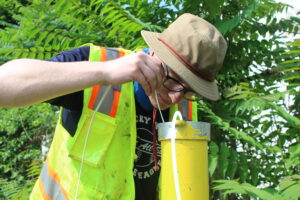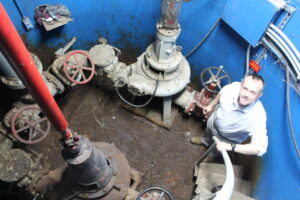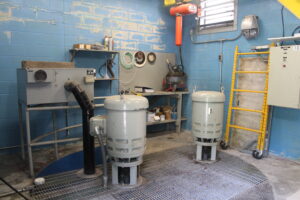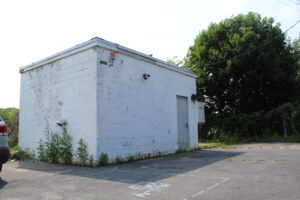By Laura Hayes, Senior Community Reporter

SHREWSBURY — The Town of Shrewsbury and its consultants have been busy monitoring a site near a water system pump station at Jordan Pond after crews discovered holes in an underground storage tank had released diesel fuel in nearby soil.
The pump station is located at 34 Ridgeland Rd.
On July 16, Shrewsbury’s consultants were conducting tests on the banks of Jordan Pond near the pump station.
“We’re actually expecting to close this [release] site if this round of testing comes back clean,” Shrewsbury’s Water and Sewer Superintendent Dan Rowley told the Community Advocate.
The Jordan Pond Pump Station is an active pump station and the sister station to a similar station on Harvey Place near Lake Quinsigamond, Rowley said.
Crews discover old tank

Several years ago, crews were working on installing a valve in the Harvey Place station when they discovered a tank while digging.
“We had no idea there were tanks there,” Rowley said.
When they discovered the tank, staff came to the Jordan Pond Pump Station and began excavating. There, they found a similar tank.
“What we believe happened is, when the stations were built in the early 60s, these tanks were installed with either a generator or backup pumping equipment that required gasoline,” Rowley said.
He continued, “Over time, that equipment changed. Unfortunately, at the time when the equipment was removed, the tanks were just left in the ground. So, as time goes on, people retire, people move on, no one knew they were there.”
Removal process reveals ruptured tank

According to Rowley, when the tanks were discovered, staff wanted to remove them. The town worked with its consultants, — which, according to its website, offers interdisciplinary design, engineering and environmental services — to create bid documents.
Rowley said the Harvey Place tank was intact when it was removed and there weren’t any detectable traces of petroleum products.
When crews were working to remove the Jordan Pond tank on June 17 of last year, though, Rowley said there was a “noticeable” odor of either diesel or gasoline.
According to the release log form filed with the Massachusetts Department of Environmental Protection (MassDEP), the tank had corrosion holes, which were observed during the removal process. Diesel fuel was released, according to the form.
During the excavation process, crews screened the excavated soil for what is called Total Volatile Organic Compounds. Those results ranged between 384.9 to 2,296 parts per million by volume, with the heaviest concentrations found along an area abutting the pump station, according to the town’s Immediate Response Action Plan.
The plan said that all of the homes within 500 feet of the tank were connected to town water.
That began a formal process with MassDEP, during which the town again engaged the services of Weston & Sampson.

When MassDEP was alerted, they gave the town and its consultants permission to start preliminary Immediate Response Action activities.
Those activities included removing up to 100 cubic yards of contaminated soil and collecting soil and groundwater samples for analysis, the plan said.
Monitoring wells were installed, which Rowley said were done “…to determine how much the petroleum moved through the soil.”
The plan said that, while officials were doing these field activities, the pond and bank near the pump station were inspected for evidence of contamination.
“No visible sheen, or petroleum odors were observed either within the pond or bank during these inspections,” the plan read.
“What they’ve determined is that the release was really confined to the grave, and [Weston & Sampson] believe they’ve gotten the vast majority of it out,” Rowley said. “What they’re seeing in the well testing is that it’s either non-detect or it’s below any actionable threshold.”
Town seeks to close site

According to Rowley, once those test results come back from the laboratory at either a non-detection level or below the actionable threshold, Shrewsbury will file and ask MassDEP to close the release site for further activities.
Rowley said he doesn’t believe that there will need to be further tests once the site is closed.
“We’ve already sampled these before, but we like to get several rounds of samples to confirm,” he said. “…If these come back clean, I think that will get us to the point that we can say with a high degree of confidence that this site is clean and that there is no further risk of contamination.”
RELATED CONTENT:
Shrewsbury selectmen vote to take land for Route 20 project (communityadvocate.com)
Square One Players to bring community theater back to Shrewsbury (communityadvocate.com)
Rep. Kane receives award from rare disorders advocacy organization (communityadvocate.com)
















